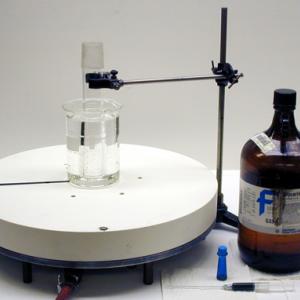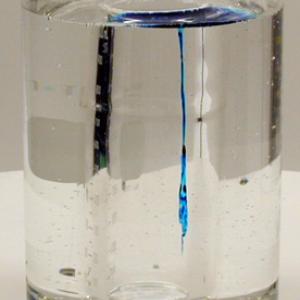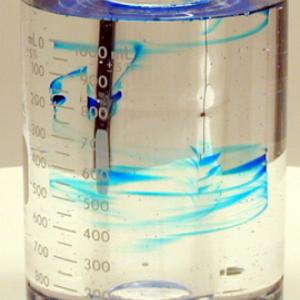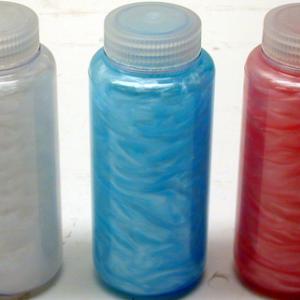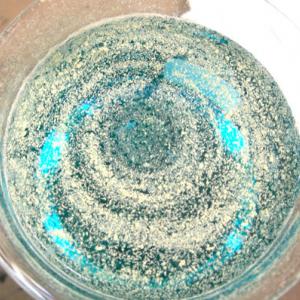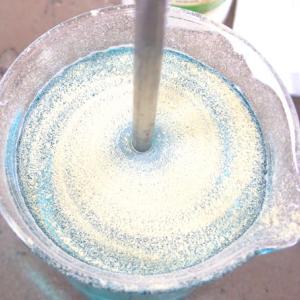College of Liberal Arts & Sciences
4F10.10 - Rotational Shear Forces - Glycerin and Ink
Clamp the test tube so that it is inserted into the middle of the beaker. Make Sure It Is Centered. Fill with glycerin (chilled glycerin works best). Inject a vertical column of ink into the glycerin with the syringe. Rotate the table a certain number of times and watch the ink seem to diffuse in the glycerin. Now rotate the table the same number of turns in the opposite direction and watch as the ink recombines into the original column. NOTE: Do not wait to long between the diffusing and recombining operations.
The Rheoscopic fluid is an easy way to show shear planes and fluid dynamics.
Shear forces in glycerin can also be demonstrated quite easily by filling a beaker with some of the reclaimed glycerin we have on hand and then placing a rotating rod in the center that is driven by a variable speed power drill. Scatter some Lycopodium powder on the surface of the glycerin to enhance the visual effect. A slow rotation rate is all that is necessary. The rotating rod must not have any wobble when spinning.
- Donald E. Rehfuss, "Current Concepts Consolidated", TPT Vol. 42, #2, Feb. 2004, p. 103.
- Stephen J. Van Hook and Michael F. Schatz, "Simple Demonstrations of Pattern Formation", TPT, Vol. 35, #7, Oct. 1997, p. 391.
- J. T. Lloyd, "Lord Kelvin Demonstrated", TPT, Vol. 18, #1, Jan. 1980, p. 16.
- V. V. Raman, "Where Credit Is Due: The Gas Laws", TPT, Vol. 11, #7, Oct. 1973, p. 419.
- John P. Heller, "An Unmixing Demonstration", AJP, Vol. 28, #4, Apr. 1960, p. 348.
- Richard J. Fitzgerald, "String Formation in Complex Fluids", Physics Today, Vol. 67, #3, Mar. 2014, p. 21.
- Russell J. Donnelly, "Recollections of Chandra", Physics Today, Vol. 64, #6, June 2011, p. 8.
- Ashley G. Smart, "Exploring the Extremes of Turbulence", Physics Today, Vol. 64, #1, Jan. 2011, p. 18.
- Wolfgang Rueckner, "Reversible Fluid Mixing", PIRA Newsletter, Vol. 14, #1, Mar. 1999, p. 4.
- "S-270. Glycerine Cylinder", DICK and RAE Physics Demo Notebook, 1993.
- G. D. Freier and F. J. Anderson, "Hm-2", A Demonstration Handbook for Physics.
- Jearl Walker, "4.131. Unmixing a Dye Solution", The Flying Circus of Physics with Answers.
- Robert Ehrlich, "I.11. Apparent Violation of the Entropy Law", Turning the World Inside Out and 174 Other Simple Physics Demonstrations, p. 124 - 125.
Disclaimer: These demonstrations are provided only for illustrative use by persons affiliated with The University of Iowa and only under the direction of a trained instructor or physicist. The University of Iowa is not responsible for demonstrations performed by those using their own equipment or who choose to use this reference material for their own purpose. The demonstrations included here are within the public domain and can be found in materials contained in libraries, bookstores, and through electronic sources. Performing all or any portion of any of these demonstrations, with or without revisions not depicted here entails inherent risks. These risks include, without limitation, bodily injury (and possibly death), including risks to health that may be temporary or permanent and that may exacerbate a pre-existing medical condition; and property loss or damage. Anyone performing any part of these demonstrations, even with revisions, knowingly and voluntarily assumes all risks associated with them.
